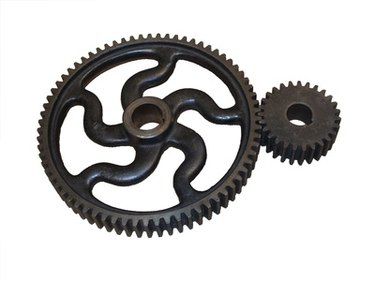Things You'll Need
Motor base RPM
Speed reducer ratio

Motors run at a specific revolutions per minute (RPM) and a speed reducer is needed if you want to keep that motor, but have a lower RPM. Calculating the RPM resulting from a motor and speed reducer assembly requires only basic mathematical knowledge.
Step 1
Write down the rated RPM of your motor; for example, 5000 RPM.
Step 2
Write down the ratio of the speed reducer; for example, 12:5.
Step 3
Calculate the reduction by dividing 12 by 5, which equals 2.4.
Step 4
The RPM of the assembly is the RPM motor divided by the reduction. In our example, it would be 5000 RPM/2.4 = 2083 RPM.
Tip
The ratio of a reducer will always be in the form of A:B, where A>B.
Warning
The RPM found should always be lower than the base RPM of the motor. If it is not, either redo your calculation or make sure you did not get a speed multiplier instead of a reducer.